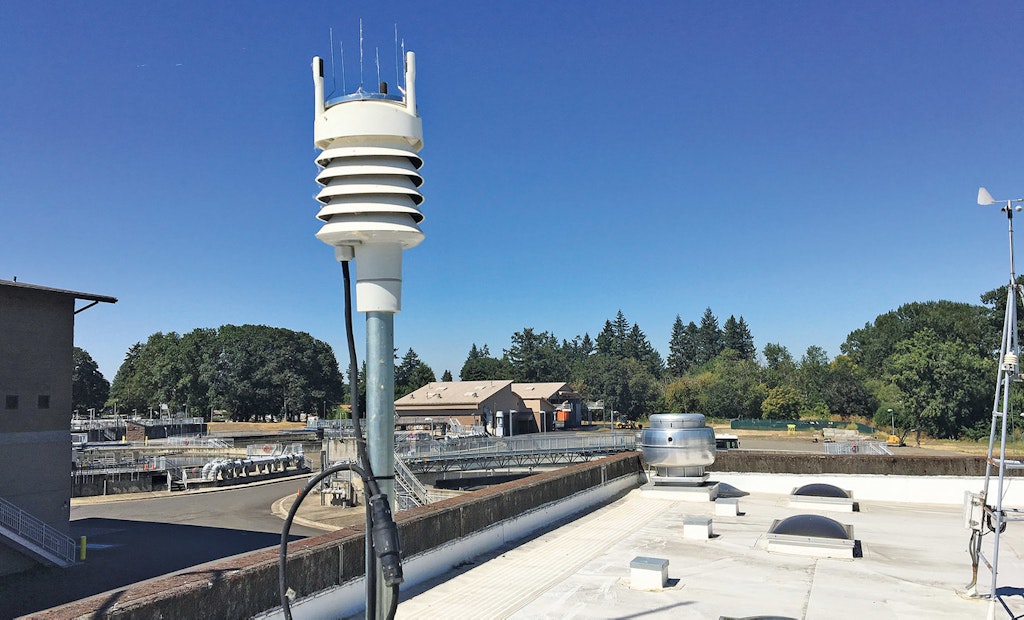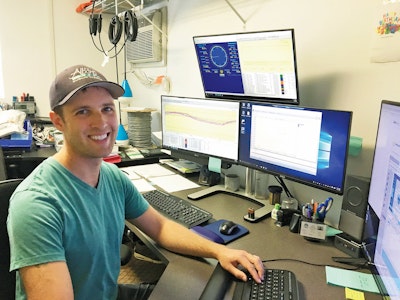
The water reclamation facility in Albany, Oregon, uses an Orion Weather Station all-in-one sensor from Columbia Weather Systems to monitor wind speed and direction with ultrasonic technology, as well as rainfall, temperature, humidity and barometric pressure.
Interested in Stormwater?
Get Stormwater articles, news and videos right in your inbox! Sign up now.
Stormwater + Get AlertsWith the rise of data-driven decision-making, weather monitoring is increasingly important for water and wastewater utilities.
The Internet of Things movement is driving society toward smartphones, smart cities, smart utilities, smart everything. Within inter-operable citywide systems, smart water can play a significant role, and weather monitoring is a part of it.
Access to timely weather information can help empower staff to maximize operating efficiency and make timely decisions. An on-site weather station can help a utility stay on top of changing conditions and respond appropriately.
Supporting operations
Whether dealing with water supply or treatment, weather affects operations. Procedures are established, taking meteorological factors into consideration. Standard decisions can be automated for normal operations and planned and documented for special circumstances.
“Certain weather conditions trigger actions at our facilities,” says Jonathon Sudar of Central Utah Water Conservancy District. “We monitor air temperature, wind speed and water temperature. We know from experience what combination of these parameters will cause ice to form on our intake screens and when we need to open the bypass gates.”
Rainfall has a significant impact on water management. For example, sewer overflows can adversely affect systems and public health. Rainfall monitoring is key to helping manage flow conditions, whether that means diverting flows or chemically treating releases.
Some normal operations based on weather conditions can be automated with a weather station interfaced to SCADA or a PLC system. Weather monitoring can be used to activate alarms for notification and to exert control based on parameters such as precipitation accumulation, high or low temperatures and high wind speed.
In case of an emergency, such as a chlorine release or spill, the monitoring of temperature, wind speed and wind direction can support effective response, community notification and decisions about evacuation.
Controlling odors
At facilities near commercial or residential areas, weather data can help forward-thinking plant managers be good neighbors and take steps to reduce odors.
If not dealt with, odor complaints can escalate, bringing negative media reports and pressure on public officials. Temperature, precipitation, wind speed and wind direction influence odor intensity and drift. For example, research shows a positive correlation between hydrogen sulfide concentrations and rising temperature, which facilitates microbial growth.
Monitoring and documenting of weather parameters can help in addressing neighborhood concerns and planning for odor control and mitigation. It helps operators understand how weather affects odors and make sense of how an odor plume disperses.
The Los Angeles County Sanitation District uses weather stations at its water reclamation facilities to help manage odor. Weather stations with 4-20mA signal interface integrate with PLC systems that use FactoryTalk software (Rockwell Automation). Automated weather monitoring provides time-stamped data for documentation and analysis when addressing complaints, and in modeling and mitigation to prevent future odor issues.
Beyond odor issues, weather data can be an important part of a water utility’s mission to serve the public and provide communication during extreme weather events that may affect service.
Reservoir conditions
Many water utilities open their reservoirs for public recreation, and these bodies of water are often in hilly terrain, subject to unique microclimates. Here, weather data can enable the utility to keep residents informed of the threats of unsafe conditions, such as rain, high winds and lightning. Weather stations are available with lightning detection in addition to monitoring of temperature, humidity, barometric pressure, wind speed and wind direction.
Believers in weather monitoring include the Jackson Bottom Wetlands Preserve in Oregon, owned by the city of Hillsboro and Clean Water Services. Created as a sewer farm to clean water polluted by canneries and lumbering, the preserve has become a regional draw for research and environmental education.
A weather station in place since 2002 is used for research and education and to provide weather data to the general public by way of Weather Underground, as well as widgets and buttons on the preserve website and city websites.
Promoting conservation
In home-based landscape watering and industrial irrigation, water conservation is based on factors such as rainfall, humidity and temperature. Public acceptance and cooperation relies on persuasive messaging that can be substantiated with weather data. Whether automated or manual, smart water usage can be as simple as whether or not it is raining, or more complex based on rainfall accumulation or evapotranspiration.
Dealing with extremes
Events such as floods and droughts are occurring more often and with greater intensity. These, in addition to winter storms with ice and high winds, affect the capacity and operations of water infrastructure and services. Managing services around such events includes monitoring conditions for operational safety, recording data for analysis and using weather data to notify the public about service disruptions or contingencies.
Analyzing data
The concept of smart water includes the use of advanced technologies and data to improve efficiency and maintain quality of life for customers. Smart water utilities are adding IoT assets such as meteorological sensors in addition to traditional monitoring of flow, pressure, distribution and consumption.
Weather information can be automatically monitored and archived for periodic and incident reporting. Historical data can be analyzed for process optimization, modeling and planning. Adaptations can be automated based on weather parameters to make adjustments for minor fluctuations and to activate emergency measures based on extreme conditions.
Sudar, of the Central Utah district, observes, “Our weather data is collected through a PLC and stored in a historian program where it can be represented graphically and reviewed. Some of the data is exported and used for modeling for our reservoirs. One place where the data is used is in evaporation modeling.”
Another example is handling of overflows. Given certain rainfall para-meters, such as the accumulation and rate, combined sewer overflow programs can divert excess flow to storage facilities for processing once a wet-weather event has subsided.
At the Albany Water Reclamation Facility in Oregon, rainfall data is combined with values collected throughout the city to provide a basin profile for meeting regulatory requirements. The data is used to determine storm event ratings when high rainfall conditions result in discharges at permitted sanitary sewer overflow sites.
Putting it together
Weather monitoring can be an important part of smart water and integrated and interoperable citywide systems. Besides serving the utility itself, climate data can improve intelligence in other areas, such as public services and energy. Efficiency is enhanced when departments can share relevant, actionable information.
Facing challenges such as climate change, revenue fluctuation, staff turnover and tightening regulations, water utilities are recognizing advanced technology as a way to give staff the best possible access to information. The data can help empower sound and timely decision-making related to multiple operations: remote pumping stations, wastewater collection, water distribution, sewer diversion, irrigation and wet-weather flow management.
For managing water supply, wastewater or stormwater, weather instruments can provide data to make operations more effective.
About the Author
Nader Khoury is president of Columbia Weather Systems. He can be reached at nkhoury@columbiaweather.com or 503-629-0887.






